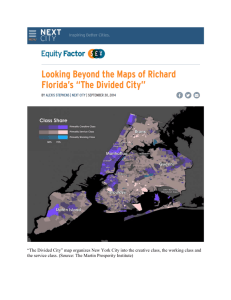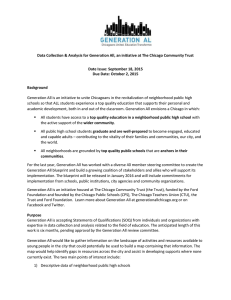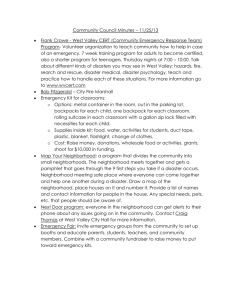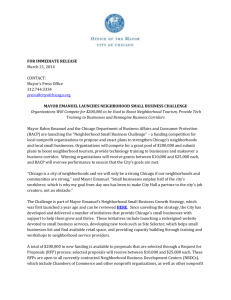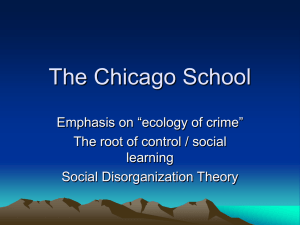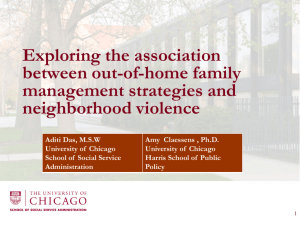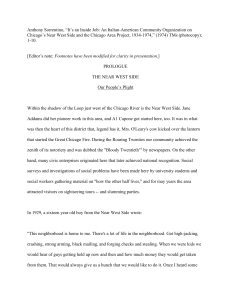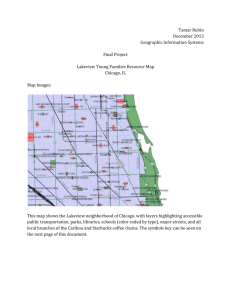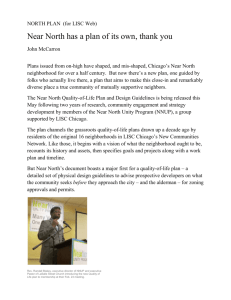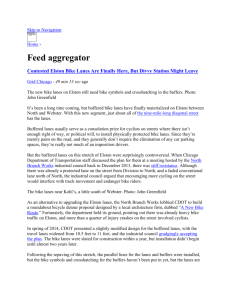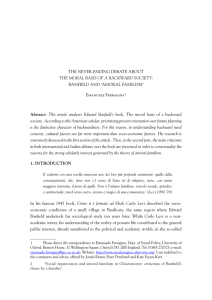Urban Crisis
advertisement
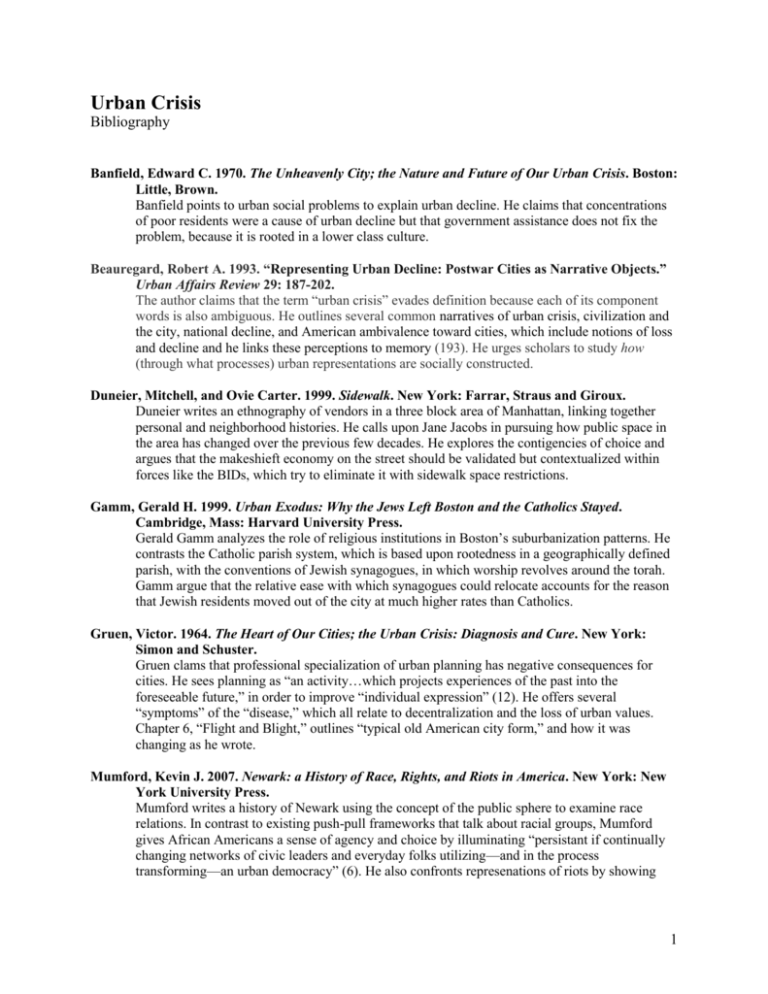
Urban Crisis Bibliography Banfield, Edward C. 1970. The Unheavenly City; the Nature and Future of Our Urban Crisis. Boston: Little, Brown. Banfield points to urban social problems to explain urban decline. He claims that concentrations of poor residents were a cause of urban decline but that government assistance does not fix the problem, because it is rooted in a lower class culture. Beauregard, Robert A. 1993. “Representing Urban Decline: Postwar Cities as Narrative Objects.” Urban Affairs Review 29: 187-202. The author claims that the term “urban crisis” evades definition because each of its component words is also ambiguous. He outlines several common narratives of urban crisis, civilization and the city, national decline, and American ambivalence toward cities, which include notions of loss and decline and he links these perceptions to memory (193). He urges scholars to study how (through what processes) urban representations are socially constructed. Duneier, Mitchell, and Ovie Carter. 1999. Sidewalk. New York: Farrar, Straus and Giroux. Duneier writes an ethnography of vendors in a three block area of Manhattan, linking together personal and neighborhood histories. He calls upon Jane Jacobs in pursuing how public space in the area has changed over the previous few decades. He explores the contigencies of choice and argues that the makeshieft economy on the street should be validated but contextualized within forces like the BIDs, which try to eliminate it with sidewalk space restrictions. Gamm, Gerald H. 1999. Urban Exodus: Why the Jews Left Boston and the Catholics Stayed. Cambridge, Mass: Harvard University Press. Gerald Gamm analyzes the role of religious institutions in Boston’s suburbanization patterns. He contrasts the Catholic parish system, which is based upon rootedness in a geographically defined parish, with the conventions of Jewish synagogues, in which worship revolves around the torah. Gamm argue that the relative ease with which synagogues could relocate accounts for the reason that Jewish residents moved out of the city at much higher rates than Catholics. Gruen, Victor. 1964. The Heart of Our Cities; the Urban Crisis: Diagnosis and Cure. New York: Simon and Schuster. Gruen clams that professional specialization of urban planning has negative consequences for cities. He sees planning as “an activity…which projects experiences of the past into the foreseeable future,” in order to improve “individual expression” (12). He offers several “symptoms” of the “disease,” which all relate to decentralization and the loss of urban values. Chapter 6, “Flight and Blight,” outlines “typical old American city form,” and how it was changing as he wrote. Mumford, Kevin J. 2007. Newark: a History of Race, Rights, and Riots in America. New York: New York University Press. Mumford writes a history of Newark using the concept of the public sphere to examine race relations. In contrast to existing push-pull frameworks that talk about racial groups, Mumford gives African Americans a sense of agency and choice by illuminating “persistant if continually changing networks of civic leaders and everyday folks utilizing—and in the process transforming—an urban democracy” (6). He also confronts represenations of riots by showing 1 that the city was unresponsive to legitmate greivances and the predominate desire to participate in civic society. Pritchett, Wendell E. 2002. Brownsville, Brooklyn: Blacks, Jews, and the Changing Face of the Ghetto. Historical Studies of Urban America. Chicago: University of Chicago Press. This detailed neighborhood history begins with a history of its early development, which begins its stigma as an area of “ignorant and dirty people,” a perception that continues through time and effects government assistance there. As conditions deteriorated and populations of African Americans and Puerto Ricans moved in, officials blamed the newcomers instead of understanding deep seeded problems. Pritchett cites obstacles at the national, city and neighborhood scales that prevented significant change, but he claims that Brownsville operates as a “point of entry” into American society, as it has from its beginnings. Rosen, Louis. 1998. The South Side: the Racial Transformation of an American Neighborhood. Chicago: I.R. Dee. Rosen offers a combination of memoir and oral histories of his old neighbors in south Boston. The book reads like a play or conversation and is anecdotal and affective rather than strictly scholarly. He presents the voices of people on “either side of the event” of population transition from predominately Jewish to mostly African American. He notes that neither he nor the people he spoke with had ever talked with anyone at length about “flight,” suggesting it is perhaps too recent or taboo in American memory. Seligman, Amanda. 2005. Block By Block: Neighborhoods and Public Policy on Chicago’s West Side. Chicago: University of Chicago Press. Seligman culls from years of the neighborhood newspaper to show that residents had tried for years to attract political aid for infrastructure in their communities. She shows that “white flight” was a complex phenomenon entrenched in decades of community frustration, not a single variable equation in which white residents simply left as soon as African Americans moved in. She also contextualizes the African Americans’ population movement into these neighborhoods. Suarez, Ray. 1999. The Old Neighborhood: What We Lost in the Great Suburban Migration, 19661999. New York: Free Press. Each chapter of this book is based in a different American city. Suarez summarizes his lament for a loss of community by explaining: “when we no longer lived and worked in proximity to one another, we no longer knew the same things. Once we no longer knew the same things, we no longer had a need for cultural cohesion” (20, 15). He claims that while other people feel this loss as well, American society generally accepts suburbanization as inevitable, and is not critical of the reasons for the postwar transformations that led to it. Sugrue, Thomas J. 1996. The Origins of the Urban Crisis: Race and Inequality in Postwar Detroit. Princeton Studies in American Politics. Princeton, N.J.: Princeton University Press. Sugrue unpacks the history leading up to the 1967 riots in Detroit, arguing that they were a result of decades of racial inequality. He demystifies the issues of deindustrialization (and the movement of plants and jobs) and white flight. He points to housing and employment as the two main areas of inequality and claims at least five causes, including the lack of relocation plans for people uprooted by highway construction and urban renewal, which disproportionately affected blacks and renters. 2
